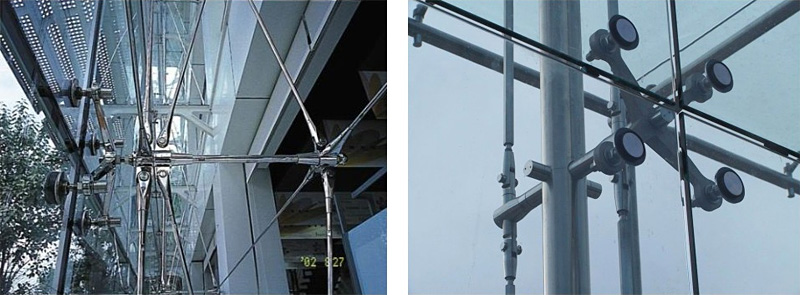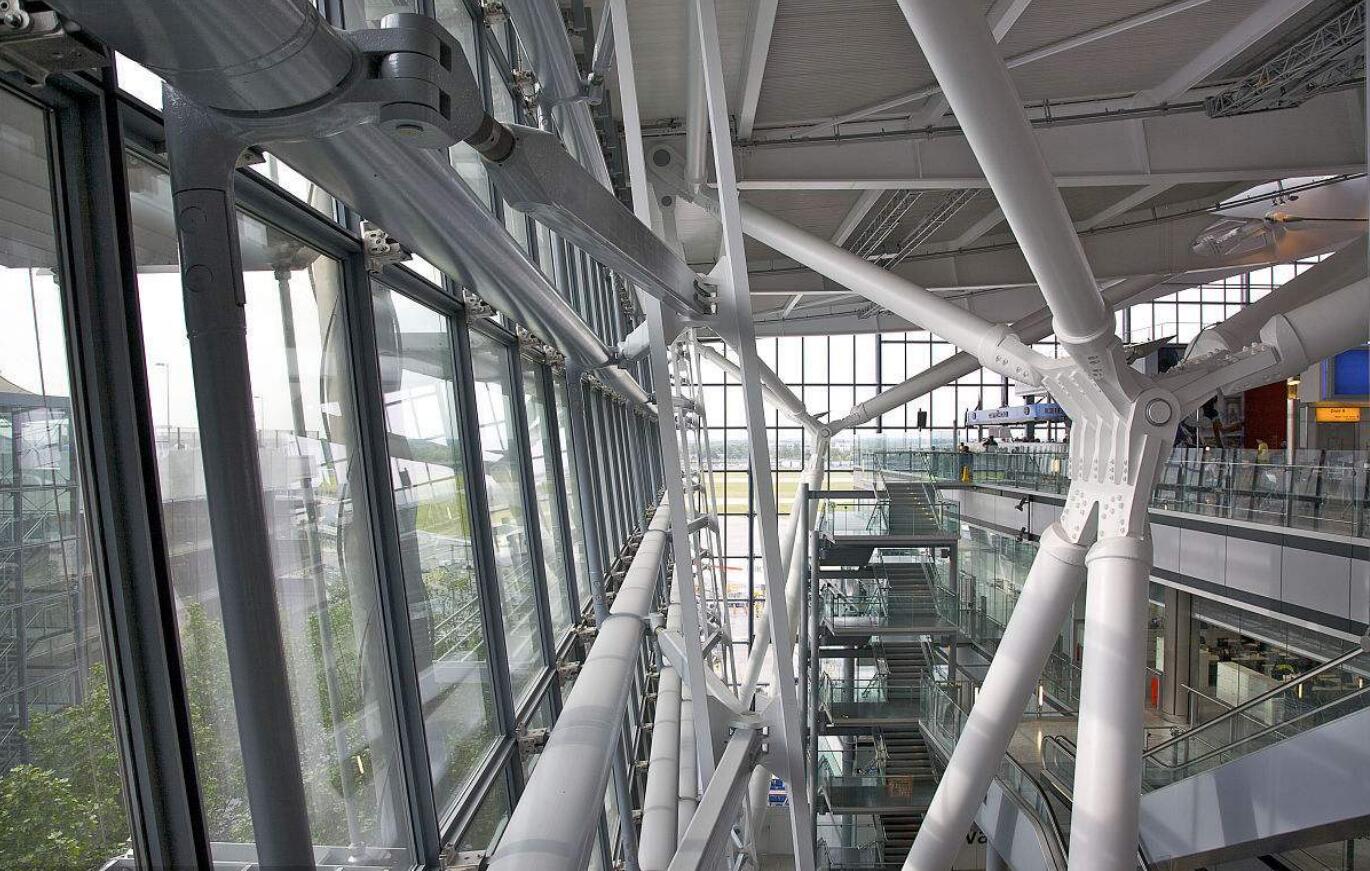Point glass curtain wall system
2024-06-25 Back
Glass curtain wall, a contemporary product of the construction industry, has been popular in Europe and the United States a long time ago. At first, it appeared in the form of a steel frame fixed on the building to form a glass wall curtain. It gradually developed to use an aluminum alloy frame to replace the heavy steel frame with extremely poor corrosion resistance. It was not until the middle of the 20th century that the glass curtain wall achieved a real breakthrough in technology and developed to the current point-type and suspended glass curtain wall systems. China has only introduced this high-tech product from abroad in recent years. The point-type glass curtain wall system has reached a mature stage in technology. It completely solves the technical problems of glass curtain wall deformation and displacement under wind pressure, snow load, thermal expansion and vibration.

An invisible structure:
The point glass curtain wall system is a supporting structural glass system that ensures that the glass can bear the load. The supports are fixed to the glass, usually bolted to the support structure through the drilled glass. Therefore, unlike traditional glass curtain walls that require glass to be set in a metal frame, this system is suitable for building facades and skylight awnings. In terms of glass types, you can choose single piece, glued, hollow, and heat-bent glass. What makes dot curtain wall glass so special? A special support design, pivots, and spacers allow the glass to bend freely under the influence of wind. The essence is that the bolts fluctuate accordingly with the fluctuations of the glass, allowing the glass to withstand very little stress. Therefore, for the same thickness of glass, using rotatable bolts can assemble a larger piece of glass than using fixed bolts and steel frames, making it more transparent and safer.

Two systems applied to single panes of glass:
1. The threaded clamping plate in the point glass system protrudes from the glass surface.
2. The countersunk head clamping bolts in point glass systems are flush with the glass surface.
Two types used in insulating glass:
1. The bolts in the point-type glass curtain wall are flush with the glass surface, and the outer surface is absolutely smooth.
2. The bolts of the point glass curtain wall only have the inner glass of the insulating glass. For safety reasons, the inner glass must be laminated glass.
Glass weight:
The upper bolts independently support the weight of individual panes of glass in point glazing systems. Each piece of glass is thus suspended. In order to prevent the bolts assembled at the lower part from bearing the weight of part of the glass, the holes in the supporting structure are designed to be waist-shaped, and the position and shape of the holes are used to compensate for the tolerances caused by displacement in different directions. For example: in a single point glass curtain wall system the upper two bolts bear the weight of the glass. The glass is also suspended, with an eccentric ring of synthetic material in each hole bearing the weight of the glass inside. These eccentric rings made of synthetic material compensate for positional tolerances of the inner and outer glass holes. In the hollow point glass system, it is the support structure of the inner glass that bears the weight of the outer glass of the insulated glass. Structural supports located between the two panes of glass also increase safety when the glass is tilted, for example in a roof where all the bolts support the weight of the glass. In order to compensate for tolerances and different displacements, it is necessary to ensure that the lower bolt can move freely within a certain range.
Support wind pressure:
When wind blows on a building, the exposed outer surface bears wind pressure, while the remaining parts bear wind suction. Wind suction is the most bothersome. The bolts are under tension and must withstand the glass without being pulled out. The size of the wind pressure depends on the location of the building (seaside, city center, etc.) and the location and height of the building where the glass is placed. The thickness of the glass depends on the wind pressure requirements. and glass size conversion. Traditional wind pressure calculations are not enough and the stress acting around the glass hole must be determined. When the wind pressure is evenly distributed on the glass surface, the load will be concentrated at the contact area between the glass and the bolts. Therefore, in order for the glass to withstand such a large stress, from a quality "safety point of view", it is necessary to use tempered glass. Deformation due to wind pressure and snow load When wind blows on the glass, the glass will deflect. Deflection occurs regardless of whether the glass is strengthened or not. Although tempered glass is much stronger than ordinary glass, it is not much better than ordinary glass in terms of bending resistance. The deflection will create a bending stress in the bolt, and as the glass forms a tilt against the bolt, the bolt will resist this movement. In order to prevent the stress caused by this bending from combining with the original high stress around the glass hole, it is basically necessary to make the glass handle freely move within a certain range, and use a pivot that can rotate or a pivot at the center line of the thickness of the glass. The gasket made of elastic material provides the elastic function of the glass to move freely within this range.

Different displacements:
At different temperatures, the thermal expansion and contraction ratios of the glass and the support bearing structure are inconsistent. This different rate of expansion and contraction will result in free movement between the glass and the support structure. In order to avoid the risk of glass breakage, a certain amount of freedom of movement between the glass and the support must fundamentally be allowed. Either of the two upper bolts must be able to move at least a certain amount horizontally and vertically. Similarly, the filler between glass and glass should be made of elastic silicone products that can resist force and pressure without shearing force. Silicone must be used for a period of time and its quality must be in good condition before use, and all modifications must be completed.




